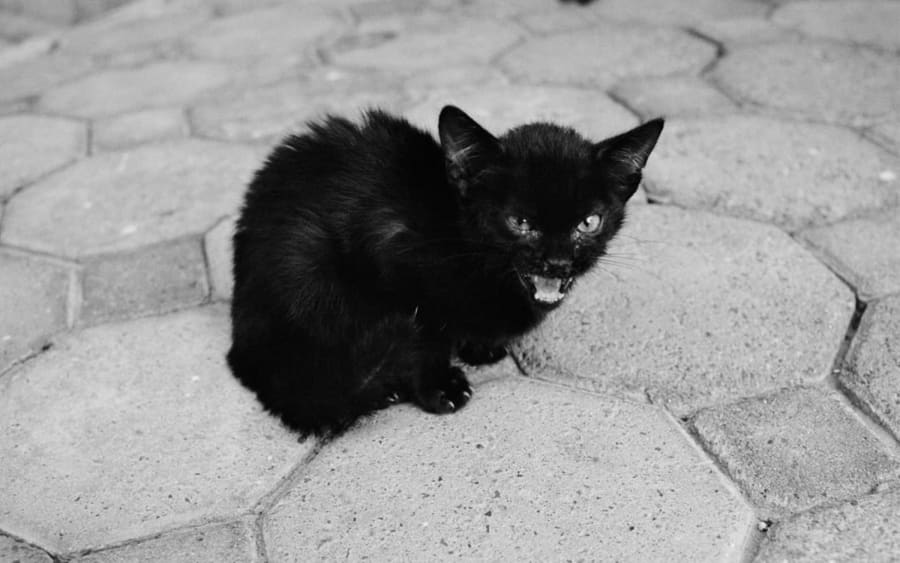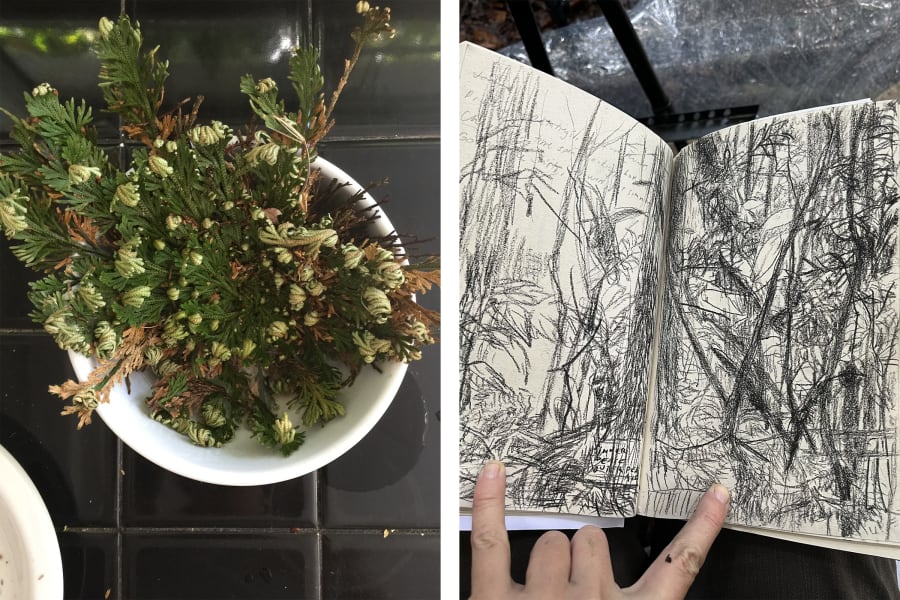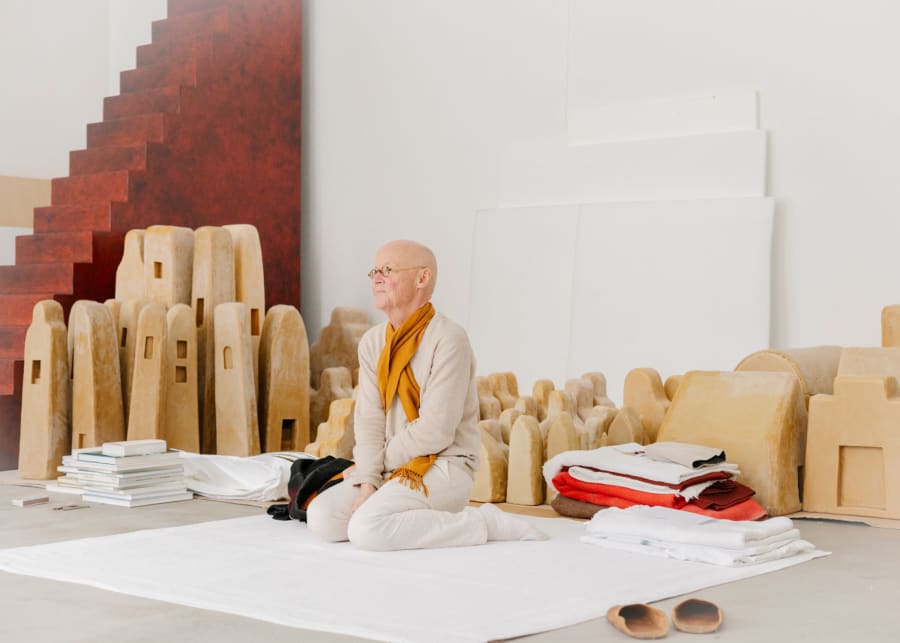Deep in a sweet chestnut wood in Kent, southern England, winter is giving way to spring. As the first bluebells of the year nose their way up from the earth, and the air fills with the tapping of a green woodpecker carving out her nest, Matthew Darbyshire is laying out axes, saws, and billhooks in preparation for the arrival of a group of students from a local art school. The British artist is best known for his sculptures, installations, and architectural interventions that cast a keen, often satirical eye over the gleaming surfaces of contemporary life, and the bleak realities that they so often conceal. This morning, however, the plan is to teach his guests how to coppice a tree, felling it near the base so that new shoots will emerge, nourished by rising sap. Darbyshire tells me it’s a practice that dates back to the stone age and, while its original purpose was to ensure a sustainable supply of timber and fuel, it’s now primarily used to promote biodiversity. In a dense wood, cutting back tree growth allows sunlight to dapple the ground, supporting a greater number of plant species, and thus more varied insect and animal life.
Coppicing is one of several conservation techniques employed by the artist and his wife, Grace, across the four acres of woodland they purchased in 2016, as somewhere ‘to escape to’ from their home in the nearby town of Rochester. Their plot is part of a far larger wood, whose human residents include off-gridders and a community of Irish Travelers. ‘It was the apparent lawlessness of this place that first attracted us,’ says Darbyshire, comparing it to the rustic setting of Jez Butterworth’s play Jerusalem (2009), in which an anarchic outsider (who might just also be the Green Man of European folklore) faces off against the forces of 21st-century order, which seek to evict him from his caravan in the woods to make way for the construction of a new housing estate. I’m reminded of the abiding role woodlands play in the national cultural imaginary as sites of resistance, and of an unruly type of transformation, from the legend of Robin Hood to William Shakespeare’s A Midsummer Night’s Dream (1595).
Working together over the past eight years, the Darbyshires have made their woods into what is at once a thriving ecosystem, an increasingly self-sufficient retreat, and a space for the production and display of art. Planting apple trees, goldenrod, and mixed native hedging has increased the population of bees, moths, and other pollinators, while fixing different-sized nesting boxes to the sweet chestnut trunks has given owls and bats somewhere to hide from the predatory buzzards circling overhead. Deer now flash through the undergrowth, while patches of churned track point to the presence of rooting wild boar. The artist and his wife have introduced a few seemingly more domesticated animals to the site: ‘chickens to provide eggs, a goat to give milk and undertake bramble control, and even, at one point, a horse, which soon put us in check with his constant bolting towards the not-distant-enough highway.’ Nature, it seems, might be stewarded, but can never be fully controlled.
Set among the trees is a cluster of habitable structures, built by Darbyshire from salvaged corrugated tin sheets and unified in black bitumen. Shipping containers have been adapted into sleeping pods with added wedge-like mezzanines; an original interwar Nissen hut has been reassembled into a workshop; a sauna functions both as a place to ease aching limbs after a day’s labors and as a kiln to dry out logs and foraged mushrooms. Power comes from a bank of solar panels, water from a 300-foot borehole, and a vermicompost loo provides not only a place to answer the call of nature, but also free fertilizer for the site’s vegetable patch. If the look and feel of these structures owes something to the black mass of Derek Jarman’s Prospect Cottage in Dungeness on the Kent coast, then they also draw on what Darbyshire describes as his ‘early obsession’ with artists working in an architectural register, such as Absalon, Atelier van Lieshout, and Andrea Zittel. ‘Their practical yet totally idiosyncratic spaces still blow my mind to this day.’
Perching on the treads of a defunct JCB digger, Darbyshire’s aluminum sculpture Galatea (2021) seems to inhale the sharp spring air. This serene female figure makes playful reference to the story of Pygmalion, from Ovid’s Metamorphoses, which tells of a Greek sculptor who fell so in love with one of his own marble carvings of a water nymph that he begged the gods to bring her to life. Galatea is one of several artworks that comprise what Darbyshire terms the site’s ‘emerging sculpture park, or maybe graveyard’, and we might recognize her as a prototype for one of his pair of aluminum public sculptures Hercules meets Galatea (2021), commissioned for the plaza of Cambridge North railway station. There, in the British university city, Darbyshire’s nymph encounters the son of Zeus, and appears unmoved by his macho posturing, the long shadow cast by his hulking, bearded form. Looking at the artist’s later bronze version of this mythological odd couple, which was exhibited in The Regent’s Park, London, as part of Frieze Sculpture 2022, it occurred to me that it not only pokes wicked fun at the figure of Hercules, but also at the authority of the whole (immutably sexist) Classical tradition.
Galatea was made using digital scanning tech and a computer-controlled CNC lathe, and many of Darbyshire’s recent works also employ cutting-edge production methods. For his 2024 solo exhibition ‘Caryatids’ at Jousse Entreprise, Paris, he presented a series of ‘furniture sculptures’ created from life-sized 3D prints of his own body, clad in scruffy studio attire, which were designed to function as useable seats, tables, lamps, and even doormats. These figures’ poses referenced key works of anthropomorphic furniture design, feminist performance art, and sculpture in the expanded field – among them Roger Tallon’s Zombie chair (1964), Helen Chadwick’s In the Kitchen (1977), and Charles Ray’s Plank Pieces (1973). The result was not only a series of witty self-portraits that mocked the trope of the heroic male artist, but also a complex, adroitly managed telescoping of different forms and histories.
The show at Jousse was laid out like a domestic space, and Darbyshire reflects that ‘creating environments is all I’ve ever done, from making minimalist sensory deprivation chambers at art school to a bronze and concrete public sculpture in central Amsterdam [11 Rue Simone Crubellier, 2018], which took the form of an apartment without walls. The woodland project is just a slower and more expansive extension of this process. I don’t think it’d be too big a stretch to say it’s become a kind of Gesamtkunstwerk.’
Voices sound in the distance. The students are almost here. Darbyshire never set out to make this woodland a pedagogical space and doesn’t advertise formal workshops. Nevertheless, hosting interested young artists ‘has become increasingly central. I don’t mind what the activity is when they come here – it could be building a geodesic dome or a dead hedge fence, or simply digging a hole together. It’s about the unexpected dynamics, and I’m at my happiest when I look around and see people chewing the fat. At a time when artists are preoccupied with ecology, climate emergency, and the carbon footprints of our individual practices, maybe this is a good place to discuss and act on these issues?’ And, with that, he moves off to greet his guests. There are tools to distribute, and green shoots waiting to be summoned from ancient roots.
Matthew Darbyshire is represented by Herald St, London, UK.
Tom Morton is a writer, curator, and regular contributor to Art Basel Stories, ArtReview, and frieze,
based in Rochester, UK.
Caption for top image: Toilet and kitchen block with sculptures from Darbyshire’s Xerox series. Photography by Matthew Darbyshire. Courtesy the artist.
Published on April 2, 2024.


